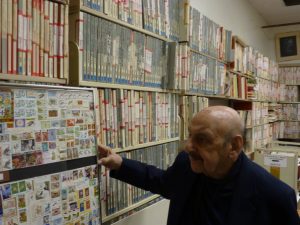Dinkenesh’s living quarters on the second floor of the
Houston Museum of Natural Science is part of a 9,000 square-foot abode
befitting a guest of her stature. Hers
is a journey that began in antiquity in a site she might be unable to recognize
or remember – a place we humans call Ethiopia.
These days, Dinkenesh – or Lucy, as some like to call the
3.2 million-year-old fossil, the oldest ever found – slumbers in a glass casing
under the watchful stare of an armed city of Houston police officer. Houstonians owe her presence here to the
Ethiopian government, museum authorities, and the exhibition’s financial
underwriters.
In other words, 2008 has been Africa’s year in Houston. In fact, this year, iFest, the city’s annual
international festival’s theme was ‘Out of Africa’ with a focus on Dinkenesh’s
homeland of Ethiopia.
This year Houston
is retelling her story. It is Ethiopia’s
year but it is Dinkenesh’s presence at the museum that has fascinated some and
irritated others. Whatever the case, she is here and her coming is noteworthy.
But, the raison d’être
for Dinkenesh in Houston
transcends her skeletal remains in the well-guarded glass case. It is an
opportunity for post-millennium Ethiopia
– the nation/state – to shine in the limelight of glory as the cradle of
humankind.
“Lucy’s Legacy: The Hidden Treasures of Ethiopia”, as the
exhibition has been named, offers – not just to the scientific novice – but to
the general public an insightful and visually refreshing tour of Ethiopia’s
five thousand year history.
It is a tour Dirk Van Tuerehout, the museum’s curator of anthropology,
is all too eager to give. Van Tuerehout has been collecting and exhibiting
fragments of human culture for the museum for the last nine years.
In Lucy’s case, Van Tuerehout doubles as guide in an attempt
to explain, in layman’s terms, the connection between modern man and the
demystifying pre-historic puzzle that is Lucy.
You see, Lucy is not quite human. She is a hominid. According to
scientists, she might be the first amongst other hominids to have walked on
twos, thus making her humankind’s common ancestor.
Her remains were discovered in 1974 by scientist Donald
Johanson and his student Tom Gray on a sweltering afternoon in Hadar, northern Ethiopia. That
night the pair joined by others celebrated to The Beatles’ “Lucy in the Sky
with Diamonds.” The pair attributes the origin of the name Lucy to that night. Ethiopians
named her Dinkenesh, which in Amharic stands for “you are beautiful.”
For a more comprehensive understanding of Ethiopian history,
Van Tuerehout provides a map and a timeline, which is divided into two eras: a
long stretch constituting the prehistoric, and a much shorter era of recorded
history. According to him this enables the viewer to understand the history of Ethiopia from
both a chronological and geographical point of view.
“Because the story is one of early humans and that’s one of
a few stories, but of course that story did not only develop in Ethiopia but in other parts of Africa like Kenya, Tanzania
and South Africa,”
Van Tuerehout says. “That is why we identify those countries in the map as well.”
He then explains that the timeline covers seven million
years of pre-history and different aspects of human development in different
parts of Africa with a focus on Ethiopia.
The map and timeline answer the “Where?” and “When?” of the narrative.
“What we are seeing is a series of photographs on top of the
timeline where we have a rendering of what Africa looked liked according to
scientists going back six, five, four, three million years ago,” says Van
Tuerehout.
The exhibit is divided into two parts: the first part
beginning in the Northern Highlands where the ancient Kingdom of Aksum
was conceived. (It is the same kingdom that would later bring forth the
Solomonic dynasty of scriptural fame that ruled a swath of that includes Eritrea and portions of Yemen).
The second part of the exhibit examines how different
species of early hominids existed in the landscape now known as Ethiopia.
Van Tuerehout then explains that Africa’s
claim to the coveted throne of humankind’s cradle is based on findings such as Dinkenesh
and a generation’s worth of scientific research.
“The focus is and remains Africa because we have the fossil
records in Africa being the oldest; we also have the representation of a chimp
identifying our closest living non-human relative, genetically speaking – but
they [chimps] themselves and their ancestors have only been and are found only
in Africa,” he says. “We have genetics and
fossil records pointing to Africa being the
cradle of humankind.”
In spite of all the excitement, pageantry and most
educational value of the exhibition, the decision to transport Dinkenesh from
its home in Addis Ababa to Houston
has drawn the ire of both prominent scientists and many members of Houston’s Ethiopian
community.
Rich Potts, director of human origins at the Smithsonian Institute
in Washington, DC, is amongst those who voiced their
concerns about the exhibit.
“I don’t know of a single Ethiopian colleague who is in
favor of Lucy traveling,” Potts says.
The Smithsonian and the American Museum
of Natural History declined to participate in the touring exhibition for
ethical reasons.
Members of the Ethiopian Community Organization in Houston
(ECOH), a non-profit organization that has been serving the Ethiopians
immigrants in the area since 1980, are also boycotting the exhibition. ECOH’s chairperson, Gigar Asfaw says that
when the debate about whether it was appropriate to transport Dimkenesh all the
way from Ethiopian for the current exhibition began in 2005, ECOH made its
position clear to all parties involved including the authorities at the museum
“We felt Lucy’s
remains were so fragile,” says Asfaw.
ECOH was concerned that the Ethiopian government and museum
authorities insisted on using the original instead of a replica for public
viewing.
“Egypt
and other countries that have historic artifacts tend to use replicas when they
travel outside,” says Asfaw. “Why did the Ethiopian government decide to bring
the original remains of Lucy?”
The organization also wanted to know if there were
guarantees that Lucy would return to Ethiopia without any foul play.
Another complaint was that Lucy had only been exhibited twice in her homeland.
By using the original fossils, Asfaw says, the authorities were not only
compromising a national and global treasure, but were also not getting back
enough in return.
Van Tuerehout, the curator, says he is not insensitive to
these concerns. But he says that Ethiopia has
been home to all three major religions – Christianity, Islam and Judaism –
making the country important in the human narrative. For that reason alone, he says, Lucy must be
seen.
The current exhibition will runs until Sep. 1.
Mshale’s Omar
Yousuf contributed to this report.
Kangsen Feka Wakai resides in Houston. He was a spring
2008 Houston
Association of Black Journalists fellow.
He is a recent recipient of a Poets & Writers Inc. writer’s
grant. His collection of poems, “Fragmented
Melodies” (Langaa Publishers) is available on www.amazon.com.
About Kangsen Feka Wakai
Kangsen Feka Wakai is a Houston based poet and writer. He is from Cameroon.
- Web |
- More Posts(2)







